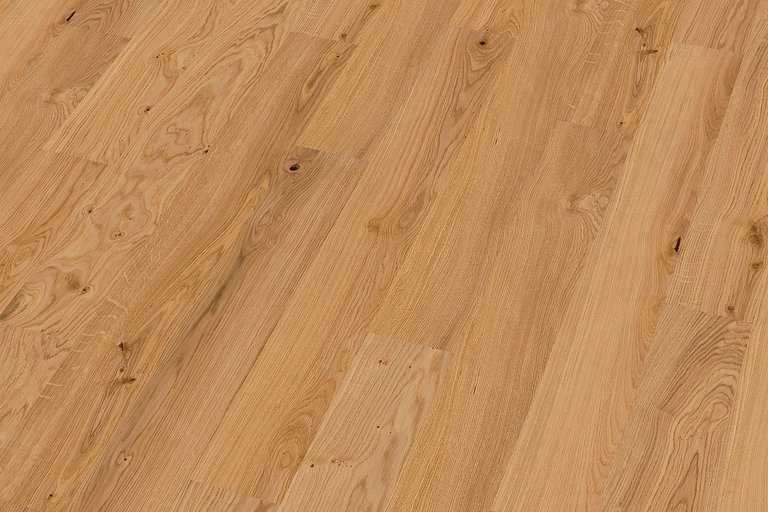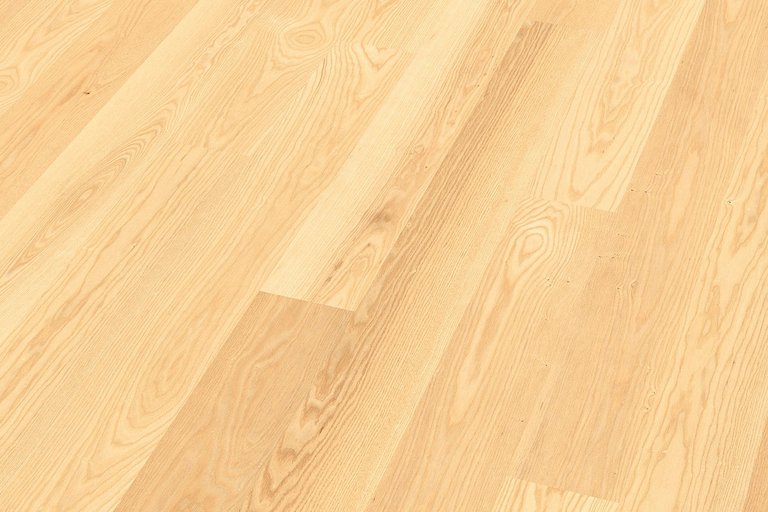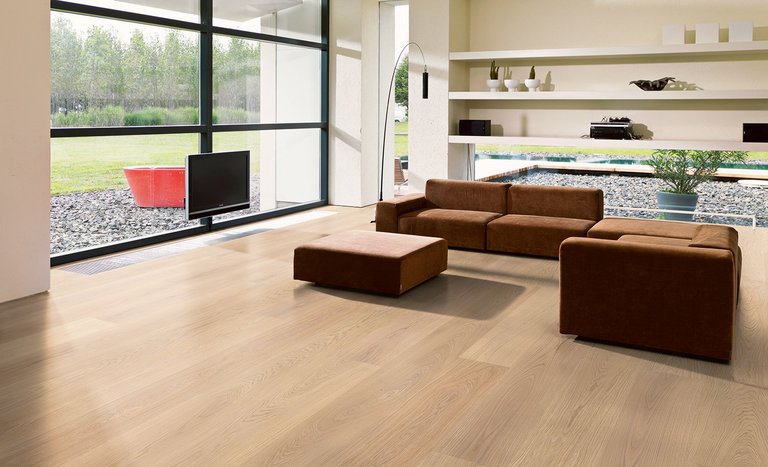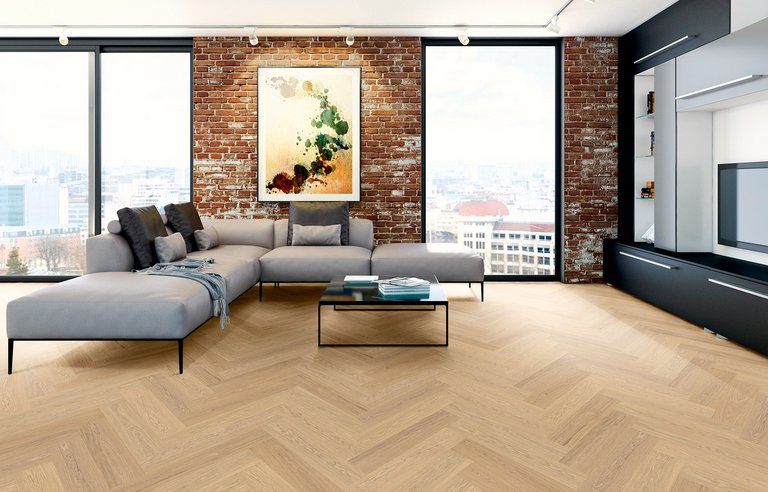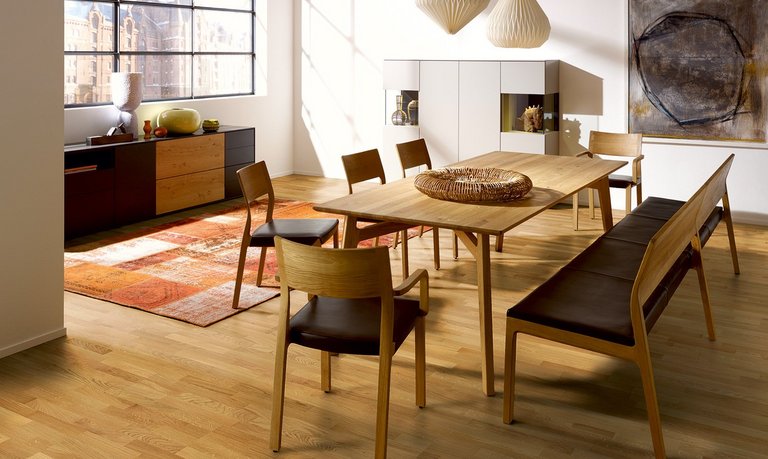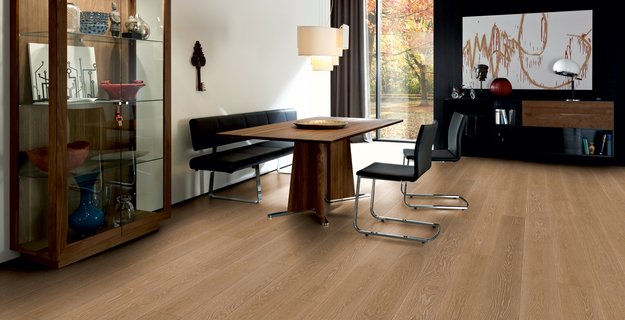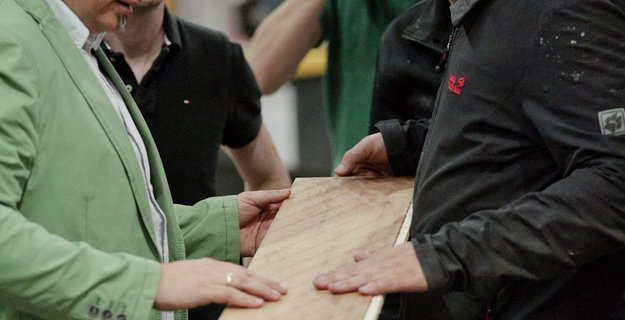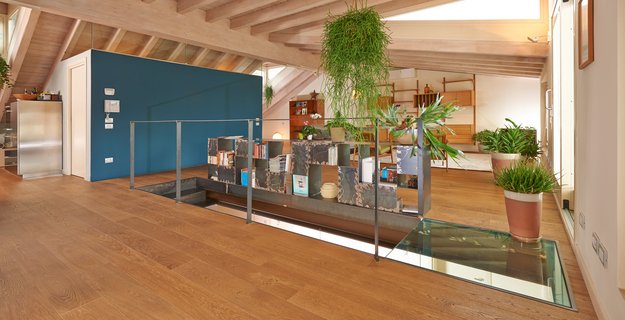![[Translate to EN:] Parkettboden aus Eiche in einem modernen, offenen Wohnraum mit großer Fensterfront. Im Wohnraum befindet sich eine beige Couch und eine weiße Küche mit Holztisch und Holzstühlen davor. Ein beleuchteter Gang mit Spots führt in einen weiteren Raum.](/fileadmin/_processed_/a/1/csm_elevation_bahamas_wf182_eiche_adobestock-836061535_115620043661_rgb_112fb242dc.jpg)
Everything you need to know about parquet flooring
A parquet floor made of real wood - the natural product from Scheucher
A parquet floor made of real wood creates a retreat full of naturalness, aesthetics and a pleasant room climate in your home.
Scheucher Parkett is an absolute expert when it comes to your parquet floor - as a renowned family business from Austria, Scheucher has been producing the highest quality wooden floors for many decades and, together with its worldwide network of specialist retail partners, will answer any questions you may have in order to find the perfect solution for your home. A parquet floor is more than just a floor covering - it is alive, gives rooms character and creates a unique living experience.
Find out in this article what you should look out for when buying parquet flooring.
What do I need to consider when buying a parquet floor?
These are the best tips before you buy!
Before you buy a parquet floor, there are a few important things to consider so that you make the right choice and enjoy your floor for a long time - because that's exactly what parquet from Scheucher is made for. Here are the most important points:
Type of parquet
Although many people still talk about solid parquet, it is hardly ever installed these days. However, this type of parquet flooring can still be found in many older houses - the floor is often several decades or even centuries old. Nowadays, multi-layer or prefinished parquet is usually installed. So if you want to buy a parquet floor, you should focus on multi-layer engineered parquet. Pre-finished parquet consists of several layers glued together and a finished lacquered or oiled surface. After installation, the parquet floor can be walked on and lived on immediately. The precious wood wear layer - the only layer of wood that remains visible from the entire structure of the parquet floor, for example oak - is approx. 3.6 mm thick with Scheucher parquet. This layer can also be sanded down several times without any problems.
Pre-finished parquet, as it is installed nowadays, with a thinner wear layer than is the case with solid parquet, is by no means inferior. On the contrary, the more stable substructure made of wood or wood-based material ensures that the parquet warps less and remains much more stable during the heating period thanks to the multi-layer structure. Nowadays, parquet flooring can be installed floating or glued down.
In addition, less precious wood is used, which contributes to the conservation of natural resources and optimizes the use of the tree.
You can find more information about the differences between these two types of parquet here.
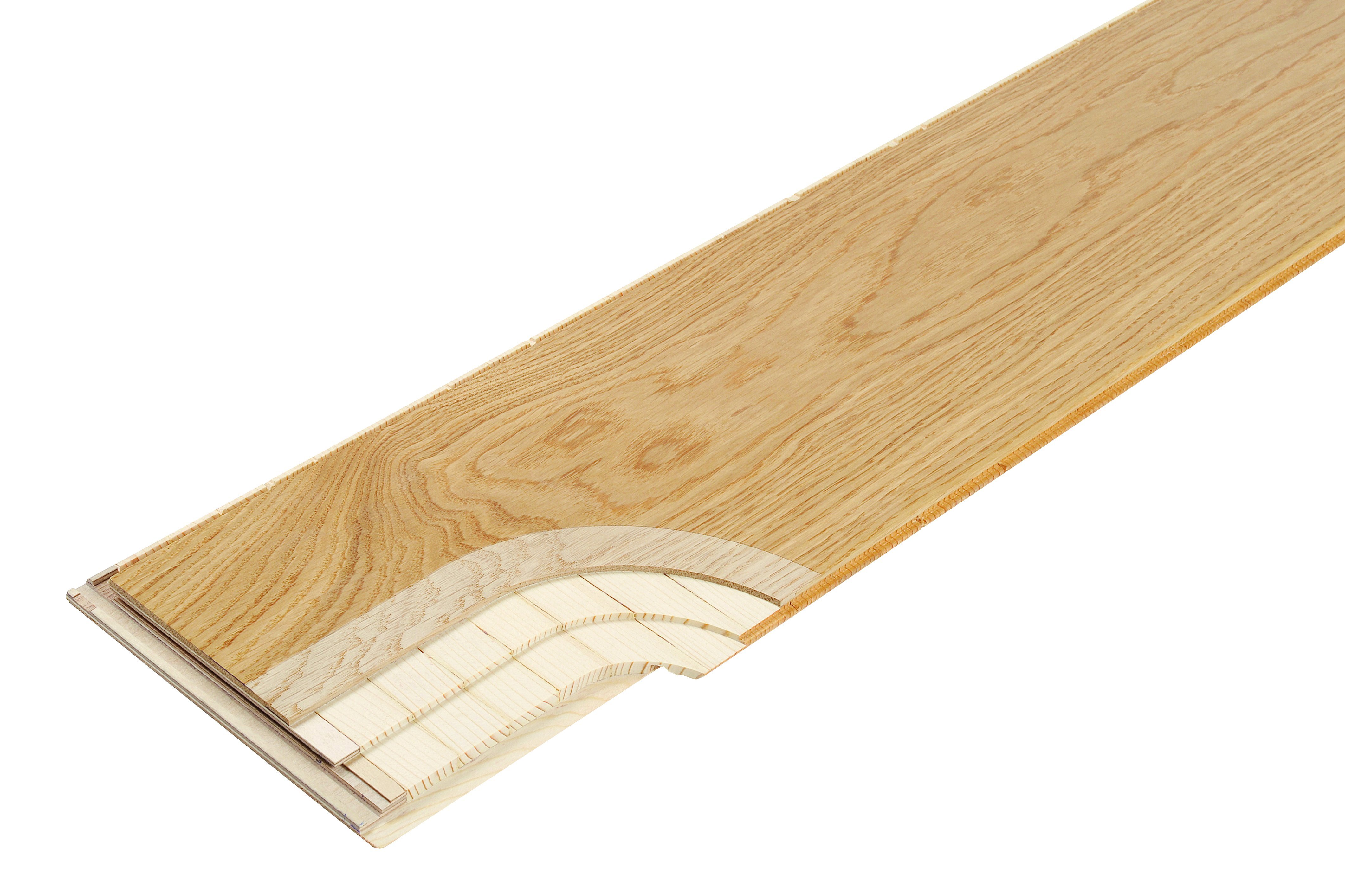
Wood types for parquet
Think about which type of wood you prefer for your parquet floor. Hardwoods such as oak are particularly hard-wearing and easy to care for. This popular type of wood is now preferred in all types of buildings and, thanks to its great ease of treatment, also offers the greatest visual and tactile choice of parquet. However, ash or walnut parquet also offer optimum conditions for a resilient and aesthetic living space. Basically, the look of your parquet flooring varies depending on the type of wood: oak has a warm, natural look, while walnut is darker and more elegant.
Here you will find an overview of all wood types at Scheucher Parquet
Surface treatment of parquet
When choosing your parquet flooring, pay particular attention to your everyday life and local conditions, pets, family members' activities and your personal preferences. Oiled parquet emphasizes the natural wood structure, is open-pored and pleasant to the touch, but needs to be maintained from time to time. A lacquered parquet floor is easier to maintain and more resistant to stains, but it is more likely to wear and show scratches over time. Both surfaces can be sanded and repaired, but in this case an oiled parquet floor scores with partial repairability. More about surface treatments here
Room temperature and humidity for your parquet floor
Parquet floors are made of wood - a natural material that reacts to changes in its environment. A constant room temperature of around 20-22 °C and a relative humidity of between 40% and 60% are ideal for maintaining the dimensional stability and durability of the parquet. If the air is too dry, the wood can shrink, leading to joint formation and cracking. Excessive humidity, on the other hand, causes the wood to swell, which can cause warping and damage to the floor. It is therefore important to ensure a balanced indoor climate - not only for the floor, but also for your personal well-being. Find out more about the right room climate for parquet and people here.
Pay attention to the room in which you want to install the parquet flooring. In bathrooms, for example, some rules must be observed due to the humidity. Here you should opt for more moisture-resistant types of parquet and follow the recommendations of the parquet manufacturer. Here you can find some information about parquet in the kitchen.
Parquet flooring in the bathroom is possible, but is subject to stricter requirements to keep your parquet flooring in top condition. You can find more information about parquet in the bathroom in this blog post.
![[Translate to EN:] Aufsatz-Waschbecken auf Eichenplatte mit Fischgrät-Parkett, schwarzer Armatur und Ausblick auf Berge.](/fileadmin/_processed_/a/f/csm_parkettboden_im_badezimmer_scheucher_referenzbild4_333f478020.jpg)
Types of parquet installation
Parquet flooring can be installed in many different ways. There are different types of patterns such as wideplank, 3-strip, strip parquet, herringbone parquet and many many more. The choice has a huge impact on the look of the room. But there are also major differences in the dimensions and installation techniques of your parquet flooring in terms of price.
Color and texture of your parquet floor
Think about which color best suits your room. A parquet floor covers one of the largest living areas in your home and should match the size of the room, the lighting conditions, the interior and the style of the house. Light and brownish floors appear larger and friendlier, while a dark floor is often more elegant. Trendy colors such as grey parquet or white oiled country house planks bring a sophisticated mix into your home.
Underfloor heating and parquet
If you have underfloor heating, make sure that the parquet flooring is suitable for installation on such a heating system. Not all types of parquet are compatible with underfloor heating systems. At Scheucher, all parquet floors are suitable for underfloor heating after professional installation/gluing. You can find detailed information on this in our flyer.
Parquet prices
The price of parquet varies depending on the structure, dimensions, type of wood, grading and surface treatment. When considering the price of your parquet floor, always remember that a parquet floor adds value and is an investment for your life and for the future.
A parquet floor is not a disposable product and will last for decades if handled properly! It also depends on the quality of the respective manufacturer - this can also vary greatly. It is also important to note that many manufacturers imitate wood, which means that not every parquet floor that looks like this is necessarily a real parquet floor. With your Scheucher parquet expert, you are sure to find the right parquet floor for your budget and style, there is something for everyone in our extensive range!
As you can see, a parquet floor is a product that requires a lot of advice and there is often uncertainty as to which parquet best suits your needs. To help you find the right look, we recommend using our parquet finder - here you can browse through part of our range, virtually lay the wooden floors in your home and order free parquet samples. You can then make an appointment with our competent partners in your area.
The most popular type: parquet flooring in oak
Oak parquet has long been the most popular flooring option, combining elegance and durability. Thanks to its natural grain and the pleasant color tones that the Scheucher Parquet range offers for the wood species oak, the parquet flooring adapts to almost any furnishing style - from modern to classic. Oak is a hard, robust wood that is particularly hard-wearing, making it ideal for areas subject to heavy use such as living rooms, hallways or offices. Oak parquet is not only a natural product from the ground up, we also pay attention to environmentally friendly production processes and sustainable forestry in the manufacture of oak parquet. This makes oak parquet flooring not only an aesthetically pleasing choice for your home, but also an environmentally conscious one.
How does the installation of a parquet floor work?
We recommend that you get advice from a professional when installing your Scheucher parquet flooring, but we'd like to share a few tips with you here for the time before your parquet flooring gets installed:
Installation of parquet flooring: the best tips beforehand
- Store the parquet flooring in such a way that it is protected from moisture.
- Do not store parquet on fresh screeds, even in new buildings; use underlay wood!
- When installing parquet flooring in new buildings, you should tilt the windows a few weeks in advance. During the transitional period or in winter, it is advisable to heat and ventilate regularly. Ensure that the correct room climate is maintained, even in empty rooms.
- Do not open the packaging of your parquet flooring until immediately before you start laying it.
- Parquet is a natural product. High room humidity can therefore lead to an excessive increase in moisture and consequently to swelling of your parquet flooring. The installation temperature should therefore not be below 18 °C and the relative humidity should not exceed 65 %.
- All damp work (tiling, painting, wallpapering, plastering, etc.) should be completed before installation.
- For a harmonious appearance, always take the planks from several packages and install them at the same time.
- Wood is a natural product and each parquet floor is unique and may show differences in color and structure. These are not grounds for complaint!
- Check the strips for any defects before laying.
Optimum installation preparation is the basis for a professionally laid parquet floor!
Suitable subfloors for parquet are cement and anhydride screeds, mastic asphalt, wood-based panels suitable for flooring or dry screed panels. However, parquet also has different requirements for the subfloor:
This must meet the usual requirements for parquet installation (evenness, dryness, cleanliness, surface strength, freedom from cracks), which are tested and recorded before installation.
- Evenness: max. 3 mm over a length of 1000 mm.
- Cleanliness check by visual inspection for possible soiling.
- Remove paint, plaster and mortar residues using a spatula. Sand off any oil and grease.
- Screed cracks must be professionally sealed with screed staples and epoxy resin.
- A trained eye must be kept on the residual moisture of the subfloor in particular before laying parquet: Cement screeds must not have more than 1.8% CM-% and anhydride screeds a maximum of 0.3 CM-% residual moisture when underfloor heating is used (factory recommendation). Without underfloor heating, the residual moisture must not exceed 2% or 0.5%.
Excessive residual moisture in the subfloor (screed or similar) is the main cause of later complaints!
Always read our installation instructions carefully before starting installation!
Clean parquet flooring but do it right
Proper care and cleaning of your parquet floor will ensure that it retains its beauty and longevity. Here are the most important do's and don'ts:
A parquet floor is a hygienic and allergy-friendly floor covering that does not attract dust due to its natural properties. Dry cleaning with a vacuum cleaner or soft hair brush is therefore generally sufficient. Damp mopping of your parquet floor, for example with Scheucher Parquet Cleaner, is only necessary if required.
Even more tips for a parquet floor that will look beautiful for years to come:
- Avoid mechanical damage wherever possible. It is advisable to lay out doormats in the entrance area.
- Sand and dirt particles should be removed as quickly as possible with a broom.
- Provide your movable furniture with parquet felt glides and use chair castors suitable for parquet for office chairs.
- Do not leave any wet objects on the parquet floor.
- In order to be able to assess the cleaning result properly, cleaning tests should be carried out on heavily soiled surfaces in inconspicuous areas. Do not use strongly alkaline cleaners or acids, as these can irreversibly discolor the parquet floor.
Always follow our care and cleaning instructions
Are you about to start your spring cleaning and want to tackle your parquet floor? You can find more tips here!
Do I have to oil my parquet floor?
With Scheucher Parquet, you receive a factory-finished, oiled / waxed parquet floor after purchase, which means that you do not necessarily have to oil your parquet floor immediately after installation. However, to ensure that your Scheucher parquet floor retains its value in the long term, initial care after installation is recommended to protect all edges from moisture penetration. Talk to your master parquet layer, they will be happy to help you.
It may also be advisable to re-oil your parquet floor after many years. Regular re-oiling of parquet ensures that the surface of your parquet floor remains protected and the natural shine of the wood is restored. Here are some important points on why and when it makes sense to oil your parquet floor:
Why should you re-oil parquet?
- Protection of the wood surface: As the parquet flooring is open-pored in the oiled version, the oil penetrates deep into the wood and continues to provide optimum protection against moisture and dirt. It forms a protective layer that makes the parquet flooring more resistant to wear and stains.
- Restoring the appearance: Over time, an oiled parquet floor can become somewhat dull. Re-oiling helps to restore the natural color and shine of the wood.
- Maintaining longevity: Re-oiling extends the life of the parquet. If the floor is maintained regularly, it will remain in good condition for years to come.
When should you oil a parquet floor?
- Depending on the frequency of use: In heavily used areas (such as hallways or living rooms), re-oiling should be carried out at shorter intervals than in less frequented rooms. Talk to your master parquet layer about the recommended intervals
- If there are visible signs of wear: If the parquet floor loses its natural shine or shows dry patches, it is a good sign that it needs to be oiled.
- After cleaning: It is advisable to oil the floor after a thorough cleaning to ensure the best possible protection.
Do the “drop test”!
If you are unsure whether your parquet floor needs to be re-oiled, you can test this carefully: if water beads up on the floor, the protection is still intact. However, if it penetrates the wood, it should be oiled.
Oiling a parquet floor is a simple and inexpensive way to maintain the floor and preserve its natural beauty.
The care and cleaning products from Scheucher Parkett are labeled with the Type 1 eco-label and are also available from your local Scheucher dealer.
Does it make sense to seal the parquet?
Whether you should seal a parquet floor depends on various factors, including the use of the room. In most cases, it is worth sealing a parquet floor if you want the floor to be particularly easy to maintain and hard-wearing.
Here are the most important considerations:
Advantages of sealing parquet floors
- Protection against moisture and stains: A sealant offers additional protection against moisture, dirt and stains. Especially in high-traffic areas such as the kitchen or hallway, a sealant can help to make the floor more resistant to everyday wear and tear.
- Easier cleaning and maintenance: Sealed parquet floors are generally easier to clean as dirt and liquids penetrate the wood surface less. This makes maintenance easier and makes the floor more resistant to wear and tear. Some of our lacquered parquet floors are also practically maintenance-free!
- Longer durability: Sealing keeps the parquet looking good for longer, as the sealed layer protects the wood from scratches, knocks and abrasion. We particularly recommend our state of the art PUROTEC surface here
If you sand down varnished parquet, you must then reseal or oil it!
Can I sand my parquet flooring myself?
Sanding a parquet floor yourself is possible in principle, but is definitely one of the more challenging DIY projects and requires a certain amount of experience, craftsmanship, optimal preparation and care. In order to carry out the sanding process correctly, it is important that the machines are guided evenly and smoothly to avoid unintentional damage. The sanding process takes place in several phases, including coarse and fine sanding and the final sealing of the surface.
We recommend that the work is carried out professionally by a competent Scheucher partner to ensure that your parquet floor retains its value and beauty. If you are confident about the work and have the right tools at your disposal, you can sand and refinish your parquet floor yourself. Here are some important points to bear in mind:
Advantages of sanding your parquet floor yourself:
- Cost savings: Sanding the parquet yourself saves the cost of professional service providers.
- Self-determination: You have control over the process and can determine the intensity of the sanding yourself.
What you need for sanding your parquet floor:
- Sanding machine: To sand a parquet floor, you need a sanding machine, sanding drum or belt sander. You can hire these from many DIY stores.
- Abrasive / sandpaper: Different grit sizes are required
- Parquet varnish, primer or parquet oil
- Chisel, chisel/wide screwdriver, wooden wedge, hammer and countersink, scraper, broom Shovel, vacuum cleaner, nails
- Lint-free cloth
- Steel spatula for joint filler
- Dust protection: Sanding creates a lot of dust. Make sure you work with a vacuum cleaner and protect the room well (e.g. with dust protection film on doors and windows).
- Cleaning agent: After sanding, you should thoroughly clean the floor to remove dust and residue.
In general, parquet is sanded down when it is visually impaired by numerous scratches, dents or signs of wear and tear; this period can vary depending on the type of wood, surface treatment and intensity of use of the parquet floor.
How much does it cost to have the parquet floor sanded?
The cost of having a parquet floor sanded can vary depending on several factors and can amount to around €50-60 per m².
Sanding parquet flooring - the costs can depend on this:
- Size of the room: The area of the parquet to be sanded is the biggest cost factor. Larger rooms or entire floors naturally cost more than smaller areas.
- Condition of the parquet: If the parquet floor has severe damage or deep scratches, it may require more intensive sanding, which increases the cost.
- Additional costs: There are often additional costs for sealing or oiling the floor after sanding. The journey of the craftsman can also affect the price.
Get a quote for sanding and resealing or oiling from our parquet professionals to find a good price.
What is important when repairing a parquet floor
A professional parquet floor repair can quickly repair minor damage and extend the life of the floor. It is important to choose the right materials and methods, identify the cause of the damage and ensure that the parquet floor has an even surface and uniform protection after the repair.
By paying attention to these aspects, you can ensure that the parquet floor remains in good condition in the long term. Depending on your level of knowledge and the type of damage, it may make sense to call in a professional. A professional floor layer has the necessary know-how and the right tools to repair the parquet floor professionally and maximize its durability.
When repairing a parquet floor, there are several important aspects to consider in order to achieve a long-lasting and aesthetically pleasing solution. Possible causes that make a parquet floor repair necessary can be moisture, heavy use, improper maintenance or structural problems in the floor. If the problem is not rectified (e.g. damp), the repairs may only help in the short term.
The right repair method should be chosen together with a professional. Minor damage to the parquet floor can possibly be repaired yourself with the right tools.
What is the price of a parquet floor?
The prices of parquet flooring can vary greatly, ranging from 30 - 160 euros per m² and even higher, depending on the type of parquet. The price is determined by the type of wood chosen, the grade and the format. As a rule, the larger the format of the parquet flooring, e.g. plank, and the purer and more uniform the grading, the more expensive it is.
![[Translate to EN:] Landhausdiele Eiche astig Perla [Translate to EN:] „Weiß geöltes Eichenparkett in einem Wohnzimmer mit petrolfarbener Wand, weißem Sofa und Esstisch mit Geschirr.](/fileadmin/_processed_/9/a/csm_woodflor182_eiche_astig_perla_hopa_shutterstock-756064708_113420039605_rgb_aad4424a6a.jpg)
Conclusion: When parquet flooring is the perfect choice
Parquet flooring is an excellent choice for almost any interior type. It combines naturalness and healthy living with aesthetics, functionality, and durability, making it a popular flooring option. Parquet flooring also positively influences the indoor climate. Here are a few reasons why parquet flooring could be the perfect choice for you:
1. Aesthetics and versatility
- Parquet flooring has a natural, warm feel and complements virtually any interior design style. The different types of parquet wood offer a wide range of design options.
- The variety of surface treatments allows you to customize the look of your parquet floor even further.
2. Durability and resilience
- A high-quality parquet floor is extremely durable and can last for decades. When it wears, it can be sanded and resealed or oiled, making it a more cost-effective option in the long run compared to other flooring options and helping to protect our climate.
3. Comfort and pleasant indoor climate
- Wood is a natural insulating material that ensures pleasant acoustics and a comfortable indoor climate. A parquet floor feels warm and pleasant underfoot, making it a particularly good choice for living spaces.
4. Care and maintenance
- Parquet floors are relatively easy to maintain. Vacuuming and occasional damp mopping are often enough to keep the floor in good condition. Minor scratches or signs of wear can be sanded and refinished.
5. Health benefits
- Parquet flooring is highly hygienic and ideal for allergy sufferers or those with respiratory problems. Learn more here.
- The natural material wood creates a pleasant and healthy indoor climate and can help manage stress.
6. Sustainability
- Parquet is a sustainable material, especially if you choose wood from certified sources such as FSC-certified wood.
- The longevity of parquet flooring also reduces resource consumption, as you won't have to buy new flooring for many years.
A parquet floor is therefore fundamentally an extremely environmentally friendly floor covering, especially when it comes from sustainable forestry and is produced and treated using environmentally friendly processes like Scheucher's. Wood is a renewable resource and has a better environmental footprint than many other floor coverings. Parquet has a very long lifespan and is a good choice for anyone who values sustainability. Recycling options and responsible disposal complete the overall sustainable picture.
7. Increase in property value
- Parquet flooring can increase the value of a property because it is considered a high-quality flooring and conveys additional value to potential buyers.
- Especially in modern or renovated homes, parquet flooring is a symbol of elegance and style.

